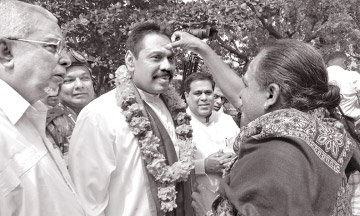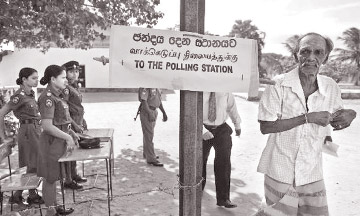Two years since UPFA
retained power at 2010 general election:
Sri Lanka marches towards new era
by K.M.H.C.B. Kulatunga
|

President Mahinda Rajapaksa is held in high esteem by all
communities
|
It was exactly two years ago that the United People’s Freedom
Alliance (UPFA) retained power at the last General Election held on
April 8, 2010.
In less than three months after the re-election of President Mahinda
Rajapaksa as the Head of State at the last Presidential election in
January 2010, the masses were given an opportunity to elect their own
representatives to the legislature.
Until this election, there was a common belief that no party could
muster a two-third majority in Parliament under the preferential voting
system introduced after the 1978 Constitution by the Jayewardene regime.
However, the UPFA, under the illustrious political leadership of
President Mahinda Rajapaksa, proved that securing a two-third majority
is almost possible even under the controversial preferential voting
system.
The UPFA created history by winning a huge majority, close to almost
two-third in the 14th Parliament of Sri Lanka at the general election
held two years ago. Under the proportional representation system
combined with preferential voting and a system of bonus seats for the
winner at district level, the two-third barrier was conceived to be
insurmountable by its crafty architect, former President J.R.
Jayewardene.
It was an election at which the masses taught an unforgettable lesson
to not only the UNP, but also the JVP. When the JVP contested the 2004
elections with the UPFA, they managed to secure a record 41 seats,
thanks to thousands of the SLFP votes they pooled when contesting under
an alliance.
Going solo
|

The UPFA created history in Parliament |
However, the JVP overestimated their strength and decided to go solo,
assuming that they could woo the sympathy votes of Sarath Fonseka.
Ultimately, the JVP ate humble pie, dashing to the ground all its hopes
of securing power by hanging on to the coat tail of a retired General.
At the 2010 General election, the UPFA secured majorities over
100,000 in six electoral districts while its majority in the electoral
district of Kurunegala exceeded 200,000. The highest majority of 322,953
votes was recorded in the Gampaha District. The then Senior Presidential
Advisor Basil Rajapaksa received a staggering 425,100 preferential votes
from the Gampaha District, the highest by any candidate at the 2010
General election. Namal Rajapaksa, by obtaining 147,568 preferential
votes from Hambantota District, recorded the highest majority
percentage-wise at the election.
The UPFA made a clean sweep in most areas to secure 144 seats in the
225-member Parliament. The election victory could be compared to the
landslide majority won by the Sri Lanka Freedom Party (SLFP) led
Mahajana Eksath Peramuna (MEP) in 1956 or the SLFP-led United Front
election victory of 1970.
The UNF won 60 seats, the TNA 14 seats and the JVP-led DNA only seven
seats in Parliament. It is clear that the ITAK that had 22 seats and the
JVP which had 41 seats in the previous Parliament had lost their former
voter base. The UPFA, for the first time, is now represented in all 22
districts and among all ethnic groups.
The UNP-led UNF of Ranil Wickremesinghe suffered one of the most
serious defeats since 1956, coming down to about 29 percent of the total
votes polled while at all past elections the percentage of votes it had
polled was around 40 percent. Several UNP Parliamentarians subsequently
joined the Government, extending the strength of the ruling party beyond
151 – the number of votes needed for a two-third majority.
Controversial referendum
Since the July 1977 general election, it had been virtually
impossible to conduct elections in each and every electorate of the
island due to LTTE terror. In 1982, the then J.R. Jayewardene regime
extended the term of Parliament with a controversial referendum and ever
since, it was not possible to conduct elections in the Tiger-held areas
in the North and the East.
However, with the elimination of terrorism and the Security Forces’
liberation of the entire country from LTTE terror under the sagacious
political leadership of President Mahinda Rajapaksa, people in the North
and the East too got an opportunity to elect their representatives to
Parliament in 2010 for the first time in 33 years.
Indeed, that was the first opportunity where the masses got to
strengthen the parliamentary group of the ruling party and they did it
in style, reposing faith on the people’s President once more.
During his first term since 2005, President Rajapaksa had to work
with a small majority of MPs elected at the last 2004 general election.
Nevertheless, the President beat all overwhelming odds in obtaining the
maximum support from Parliamentarians to lead the Security Forces to a
decisive victory.
|

Elections were held in the North and the East too |
Considering the landslide victory secured by President Rajapaksa with
a majority of over 1.8 million votes at the January 2010 Presidential
Election, the masses provided the ruling UPFA an even larger number of
votes at the General Election.
The remarkable election victory of the UPFA reaffirmed the faith of
the public in the policies of President Rajapaksa who inspired the
Security Forces to win the humanitarian battle against the LTTE
terrorists and also started mega development projects as well as smaller
but useful development programs such as building and rehabilitating
rural and plantation roads and housing.
Voting patterns
It is clearly visible from the voting pattern of the rural
agricultural regions that the majority farmer community had given a
decisive mandate to the UPFA, especially as a result of the national
food production drive catalysed by the fertiliser subsidy.
While liberating the country from the clutches of terrorism, the UPFA
Government has taken the country towards new economic horizons by
undertaking many mega development projects, of which many have already
been completed.
When we saw super highways in other countries several years ago, we
even in our wildest dreams never thought that it would be a reality in
Sri Lanka. However thanks to the clear-cut political and development
vision of the President Rajapaksa under Mahinda Chinthana all Sri
Lankans could now boast of similar facilities.
The Southern Expressway has been a big boost for economic development
not only in the Southern Province, but also in other adjoining provinces
as well. It has helped both the public and the business community by
saving their precious time in meeting present day challenges. The
Kottawa-Galle Southern Expressway will be extended to Matara in the near
future. Similarly, construction of Colombo-Kandy Highway, Bandaranaike
Airport Expressway and Colombo Outer Circular Road are now in progress.
Since President Rajapaksa took the destiny of a country with a shaky
economy and uncertain future due to terrorist threats, in November 2005,
Sri Lanka has made an unbelievable progress in all spheres, be it
economic progress, development, national security or any other aspect.
The key to such transformation is the political sagacity of President
Rajapaksa, who has been on an ambitious program to eradicate terrorism
and to take country towards new economic horizons.
Development projects
Apart from the Southern Highway, several other mega development
projects such as the Kerawalapitiya Power Plant, Upper Kotmale
Hydropower Project, Norochcholai Coal Power Plant and Hambantota
International Harbour have already been completed. For the first time in
Sri Lanka’s history, five ports were constructed and developed to meet
international standards. Several mega irrigation projects, including Uma
Oya, Kumbukkan Oya, Rambakan Oya and Moragahakanda Reservoir have
already been completed, spending a colossal sum of money for development
activities at a time the country has to spend staggering amount of
rupees for national security and social welfare.
Among the other mega development projects that are currently under
way are Mattala International Airport, Colombo Port expansion project
and re-development of Katunayake International Airport.
President Rajapaksa’s decision to extend the fertiliser subsidy
beyond paddy cultivation has enabled the country to take a giant leap
forward in the agricultural sector. More importantly, the people who
have been rescued from the jaws of LTTE terror and resettled in the
North and the East with a new lease of life have now started making an
active contribution to the national coffers.
Over the years, the UPFA has proved its popularity both in the urban
and rural areas, increasing its vote base further, following its
resounding victory at the last presidential and general elections. Be it
the North Central, Southern or Uva Province, the UPFA has inflicted a
humiliating defeat on the United National Party (UNP), which again has
been relegated to the losing camp under the insecure leadership of Ranil
Wickremesinghe.
The President’s next goal will be to guide Sri Lanka towards economic
prosperity, similar to how he commanded the Security Forces to a
convincing victory over LTTE terrorists. Time and again Sri Lanka has
proved to the world that we are a nation with a proud history and would
not play second fiddle to extraneous forces.
Culture and heritage
We have a rich culture and heritage which is second to none.
President Rajapaksa has created the right atmosphere for all Sri Lankans
to feel proud of their nation. Despite many conspiracies hatched in the
West, the President is fearlessly meeting the challenge in protecting
the people of Sri Lanka and the country’s sovereignty.
Never before in history have we felt so proud of our nation. The
military successes in the battle against ruthless terrorism have made
all of us feel strong and determined. Though most governments earlier
either bowed to foreign pressure or made a business out of the conflict,
President Rajapaksa has proved himself a true patriot and a true son of
the soil. This has enabled all citizens - Sinhalese, Tamils, Muslims and
Burghers - to hold their heads high.
The President has been instrumental in developing a new thinking and
a greater feeling for our country. As a nation, we would by no means
compromise our culture, values or dignity. The right political
leadership, coupled with the steadfast commitment of our indomitable
Security Forces, has created a conducive atmosphere where all of us
could feel proud and stand tall as one nation.
In this scenario, Sri Lanka will prosper towards new economic
horizons under the Mahinda Chinthana Idiri Dekma. The President and the
UPFA Government would work tirelessly to achieve this goal and it’s the
duty of one and all to make a tangible contribution to achieve that
cherished goal.
Sri Lanka is marching towards a new era, under President Rajapaksa
and his UPFA Government. It is the duty of all Sri Lankans to shed
political differences and work together to usher in economic prosperity
by 2017. |

